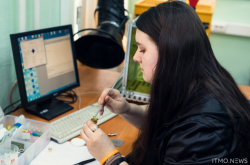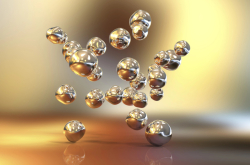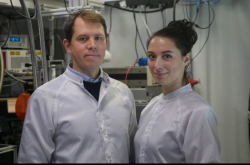What sort of research do you plan to do at ITMO University?
Two-dimensional materials are a relatively new field of research that began with the discovery of graphene in 2004. The importance of that research was immediately understood by the scientific community; just six years after the first experiments, the scientists Andre Geim and Konstantin Novoselov were awarded the Nobel Prize in Physics. But graphene isn’t the only two-dimensional material. There are many other materials with a layered structure from which we can extricate a single layer. My work here revolves around studying the optical properties of atomically thin semiconductors, which I believe are some of the most promising two-dimensional materials. An important quality of semiconductors is that they absorb light of a specific wavelength and that quality depends on the specific sample’s structure. The absorbed energy goes towards connecting the positive and negative charges into new complex particles, excitons. This happens in atom-thin semiconductors, too, and is currently the focus of many research projects.
We try to think one step ahead and want to learn how to create even more complex particles, called exciton-polaritons, which are produced when an exciton interacts with a photon. Exciton-polaritons are incredibly interesting and lead the way to studying such unusual physical phenomena as Bose-Einstein condensation and polaritons superfluidity. Exciton-polaritons have practical applications, too, for instance in the creation of polaritons lasers with ultra-low lasing thresholds. These energy-efficient, and, in case of 2D materials, nano-scale lasers and optical transistors could serve as a basis for optical computers.
So, you will study the new properties of two-dimensional semiconductor structures. How well-researched is this topic today?
We will create, or, rather, are already creating hybrid structures based on two-dimensional materials and, for instance, nano-structured waveguides. This should let us create these supercomplex particles, exciton-polaritons. I would say that interest in this subject is currently on the rise, and it’s a great field of work because there are so many interesting tasks here that haven’t been done yet simply because they’re too new.

What possible goals will this research have?
One of the major goals is the creation of hardware components for next-gen optical computers and telecommunication networks. But you have to take small steps to get to the final goal, and right now we’re focusing most of all on the fundamental task of creating exciton-polaritons in two-dimensional materials. We also have to study their properties, such as the bonding force between the excitons and photons, and, of course, we have to learn how to control these properties.
What made you swap the laboratory at the University of Manchester for a laboratory at ITMO University?
Changing your place of work every once in a while is common practice among scientists. We do it to acquire new knowledge and skills. Here at ITMO University, you have a strong team of nanotechnology and optical scientists and, despite their young age, they have a lot of high-quality articles published in respected publications. I also learn a lot from the experimental scientists who work here. In Manchester, I worked on electronic transport, which is more about solid-state physics. I was interested in trying something new and gaining deeper knowledge about optics. Besides, in my final few months in the UK, I studied photoluminescence in two-dimensional materials and found that very interesting.
I found a job offer from the Laboratory of Light-Matter Coupling in Nanostructures on a regular job hunting website. They were looking for an expert on two-dimensional materials. I had the opportunity to stay in the UK, but I don’t regret moving, because the people here are enthusiastic, goal-oriented, and yet very supportive of each other. And the staff here are quite young, which is also great.

You also have some experience of working at Andre Geim and Konstantin Novoselov’s laboratory. What is the most important thing you learned from them?
Their attitude towards their work. I see the same in my colleagues at ITMO University, but I wish all scientists were like this. It’s all about responsibility, a commitment to results. It doesn’t matter what obstacles you face, you have to overcome them, be it technical difficulties or organizational issues. The objectives must be completed. Andre Geim and Konstantin Novoselov are heads of laboratory who work seven days a week. Seeing examples such as these motivates you greatly.
How did you end up getting a PhD in the UK?
Back when I was a student at Moscow State University, I realized that I enjoyed experimental work. I was doing a thesis project at a lab with the scientists who were among the first to grow graphene. When I was looking for a place to do my PhD, I wrote to Irina Grigorieva, a professor at the University of Manchester. She liked my CV and suggested a project which I could use to apply for the UofM’s scholarship for international students. I got the scholarship and in just a few months I was already working in Manchester.
What was your research there about?
Most two-dimensional materials are stable in normal conditions, but there are layered crystals that can be split into atom-thin layers that oxidize when left in contact with oxygen. These are usually metals, and at low temperatures they exhibit unusual qualities such as superconductivity. My main goal was to solve the issue of stability of atom-thin layers of these easily-oxidizing materials, to find out how to use them in the creation of various measurement devices for electron transport and to study these materials’ two-dimensional superconductivity.

What were your biggest achievements during your time as a PhD student?
I’d say the most interesting one had to do with superconductivity: it required the most effort, but also made me grow as a researcher. You see, for many years there was no clear answer to a fundamental question: can superconductivity exist in two-dimensional systems? The main challenge was to find a suitable, ordered two-dimensional system. Everything we had prior to that was either too unordered or not thin enough to be considered two-dimensional. Extricated atom-thin layers, however, retain their crystal structure and are the ultimate physical version of a two-dimensional system; after all, what is thinner than an atom?
In the end, we managed to prove that superconductivity can indeed exist in two-dimensional systems and that it’s quite stable. The special system we created to produce atom-thin layers in an inert atmosphere also allowed us to create various devices with two-dimensional superconductors and study their properties in great detail.
Have you ever had any eureka moments when you finally got what you were working towards?
Of course I have, but even those moments tend to be a result of great labor. Sometimes you’ll struggle with something and keep failing, and when you finally try the last method, it works. Some ideas you just have to let go of, because they just don’t work. But we learn from bad results more than we learn from the good ones.

What do you like the most about your work? What is your working process like; do you stay up from dawn till dusk?
There are many scientists out there whose work schedule is highly intense, and you have to match their pace just to stay on par with them. Another stimulus is the thrill of competition because research today is a lot like a race. There are many examples of several groups being on the verge of the same massive discovery at the same time, but only one made the discovery; there are no “second trailblazers”. So yes, sometimes you have to work from dawn till dusk. This is normal, and that’s how it was at the University of Manchester, too. The only difference was that their infrastructure was better developed, and we didn’t need to deal with, say, buying the equipment, which is what my colleagues at ITMO and I are busy with right now, because we’re building a new system for manipulating two-dimensional materials. Still, to me, this is a new and interesting experience.
Of course, there is a bit of burnout sometimes, especially when you go for too long without producing any results, but you learn to deal with it. For example, what helps me is talking to my friends, many of whom are also physicists. I enjoy experimental work at the lab, and the best thing is when you get a new result and need to interpret it correctly. In those cases, the help of your colleagues is invaluable, which is why I’m glad that I work at ITMO University with competent professionals.
What are your next goals here?
As I’ve mentioned, we’re currently building a system for the production of heterostructures. Soon, we’ll start the experiments and create two-dimensional heterostructures right here at the university. Thankfully, we have enough funding to do this kind of experimental work. That’s why we’re open for collaboration with new Master’s and PhD students who can learn to work with two-dimensional materials from us. It’s a broad topic that covers solid-state physics and optics. We welcome all bold and ambitious young scientists.





